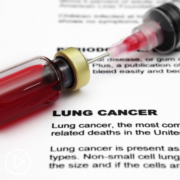What Is Advanced Non-Melanoma Skin Cancer and How Is It Staged?
What Is Advanced Non-Melanoma Skin Cancer and How Is It Staged? from Patient Empowerment Network on Vimeo.
Dr. Advanced non-melanoma skin cancer encompasses several skin cancer types. Dr. Diwakar Davar discusses the most common types of advanced non-melanoma skin cancer and factors involved in staging.
Dr. Diwakar Davar is the Clinical Director of the Melanoma and Skin Cancer Program at UPMC Hillman Cancer Center. Learn more about Dr. Davar.
See More from Evolve Non-Melanoma Skin Cancer
Related Resources

|

Expert Advice for Newly Diagnosed Advanced Non-Melanoma Skin Cancer Patients |

Emerging Treatments for Advanced Non-Melanoma Skin Cancer: What’s Showing Promise? |
Transcript:
Katherine:
Today, we’re focusing on the most common forms of advanced non-melanoma skin cancer. What does it mean to have advanced non-melanoma skin cancer?
Dr. Davar:
Sure. “Non-melanoma skin cancer” is actually a very broad, heterogenous term and includes patients with cutaneous squamous cell carcinoma, which is actually the commonest cancer in the United States with approximately 1 million cases a year, the vast majority of which are actually not necessarily, particularly serious or deep but do indicate predisposition towards further cancers and exposure to carcinogenic ultraviolet light.
It also includes the entities of Merkel cell carcinoma as well as basal cell carcinoma. These common cancers ranging from very common cutaneous squamous cell carcinoma to the least common Merkel cell carcinoma and basal cell in between are primarily seen in Caucasian patients. There is a predisposition towards these cancers we discovered in patients who are older, and certainly there is a predisposition in finding these cancers in certain anatomical regions such as the head and neck areas. Most of these cancers happen in older Caucasian patients, typically above the clavicle in the head, neck, around the ears, and on the cheeks and the face.
Katherine:
Why is that?
Dr. Davar:
Well, the primary etiologic agent driving carcinogenesis in these cancers is ultraviolet light.
Again, the vast majority of ultraviolet light exposure happens to people before the age of 12, and it happens predominantly on the head and neck because that is the area that is most exposed to the sun. The cancer takes a while to form because the carcinogenic effects take a while to cause the cancer. So predominantly, patients, as they start hitting their 70s and 80s, it becomes increasingly common and occasionally, these cancers can actually end up being serious and start causing advanced cancers.
Katherine:
What does it mean to have advanced non-melanoma skin cancer?
Dr. Davar:
You know, in most cases, the definition of what is considered an advanced cancer is stage IV disease. If you have lung cancer, advanced lung cancer is stage IV cancer that has spread to the opposite lung, or to the brain, or the liver.
If you have advanced melanoma, it is cancer that has spread to a distant organ such as the lung, the liver, or the brain. Skin cancer is very, very different. Because of its unique anatomical location, even a large tumor that potentially can be cut out but hasn’t necessarily spread can still threaten vital organs. You can have a 3 cm tumor near the eye that is threatening the globe. If it is not shrunk, the surgical resection of this tumor will potentially involve removing the eye.
Similarly, you can have a very large tumor that is not necessarily spread, but is involving the right side of the cheek near the jaw in which case, the potential surgical removal of this tumor would involve the extremely disfiguring surgery of jaw removal, what is known as mandibulectomy.
Given the nature of these tumors and the location of these tumors, the definition of locally advanced for this particular cancer has started to incorporate more elements of the location and the ease of which the cancer can be removed, which is very distinct from cancers in other locations, and also the proximity of these cancers to critical structures such as the nose, the lips, the eye, as well as critical vascular and neurovascular structures in the neck, such as the carotid artery, the internal and external jugular veins, and the vagal nerve bundle.










